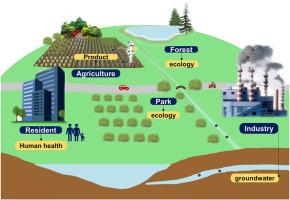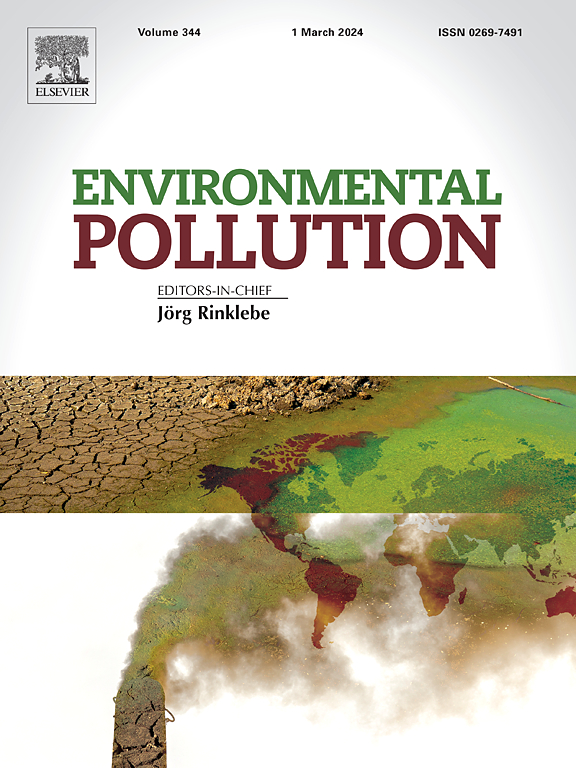Dynamic estimation of the soil environmental carrying capacity for Benzo(a)pyrene in an industrial city, China: Insight from both duration and rate of regional emission
IF 7.6
2区 环境科学与生态学
Q1 ENVIRONMENTAL SCIENCES
引用次数: 0
Abstract
An in-depth investigation of the maximum environmental load is crucial for soil security and pollution prevention. This research focused on soil environmental carrying capacity (SECC) for different risk receptors in a Chinese industrial city. By determining risk threshold for various land use types, we integrated mass balance and iterative models to capture dynamic net input fluxes with spatial heterogeneity. This enabled quantitative characterization of Benzo(a)pyrene (BaP) SECC through top-down and bottom-up approaches (corresponding to duration (D) and rate of regional emission, respectively). The thresholds were in the order of agricultural land < residential land < forest < industrial land < park. The top-down analysis showed D increased ∼1.5x with a 5% input flux decline until 2031. The bottom-up analysis suggested industrial emissions decreased by approximately 10% as the pollution control period was extended from 20 to 50 years. Both methods showed that at maximum background values (C0), D was ∼4x and the industrial emission rate was ∼10% higher than at minimum C0. SECC values near industrial areas significantly decreased, even reaching negative values, signifying complete carrying capacity loss. This study provided an approach to the dynamics of SECC under diverse scenarios, aiding informed decision-making for sustainable land management.


中国某工业城市土壤环境对苯并(a)芘承载力的动态估算:从区域排放的持续时间和速率中获得启示
深入研究最大环境负荷对土壤安全和污染防治至关重要。本研究的重点是中国某工业城市不同风险受体的土壤环境承载力(SECC)。通过确定不同土地利用类型的风险阈值,我们整合了质量平衡和迭代模型,以捕捉具有空间异质性的动态净输入通量。这使得我们能够通过自上而下和自下而上的方法(分别对应区域排放的持续时间(D)和速率)对苯并(a)芘(BaP)SECC 进行定量描述。阈值依次为农业用地、居住用地、森林、工业用地和公园。自上而下的分析表明,到 2031 年,D 增加了 1.5 倍,输入流量下降了 5%。自下而上的分析表明,随着污染控制期从 20 年延长到 50 年,工业排放量减少了约 10%。两种方法都表明,在最大背景值(C0)下,D 是最小 C0 的 4 倍,工业排放率比最小 C0 高 10%。工业区附近的 SECC 值明显下降,甚至达到负值,表明承载能力完全丧失。这项研究提供了一种在不同情景下研究 SECC 动态的方法,有助于为可持续土地管理做出明智决策。
本文章由计算机程序翻译,如有差异,请以英文原文为准。
求助全文
约1分钟内获得全文
求助全文
来源期刊

Environmental Pollution
环境科学-环境科学
CiteScore
16.00
自引率
6.70%
发文量
2082
审稿时长
2.9 months
期刊介绍:
Environmental Pollution is an international peer-reviewed journal that publishes high-quality research papers and review articles covering all aspects of environmental pollution and its impacts on ecosystems and human health.
Subject areas include, but are not limited to:
• Sources and occurrences of pollutants that are clearly defined and measured in environmental compartments, food and food-related items, and human bodies;
• Interlinks between contaminant exposure and biological, ecological, and human health effects, including those of climate change;
• Contaminants of emerging concerns (including but not limited to antibiotic resistant microorganisms or genes, microplastics/nanoplastics, electronic wastes, light, and noise) and/or their biological, ecological, or human health effects;
• Laboratory and field studies on the remediation/mitigation of environmental pollution via new techniques and with clear links to biological, ecological, or human health effects;
• Modeling of pollution processes, patterns, or trends that is of clear environmental and/or human health interest;
• New techniques that measure and examine environmental occurrences, transport, behavior, and effects of pollutants within the environment or the laboratory, provided that they can be clearly used to address problems within regional or global environmental compartments.
 求助内容:
求助内容: 应助结果提醒方式:
应助结果提醒方式:


